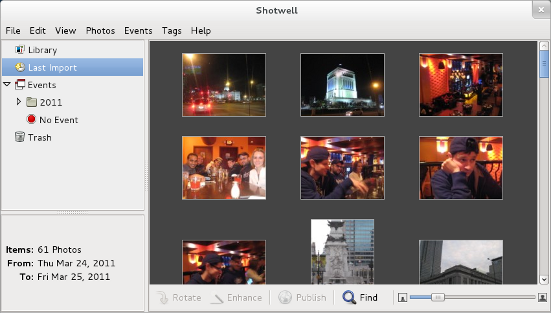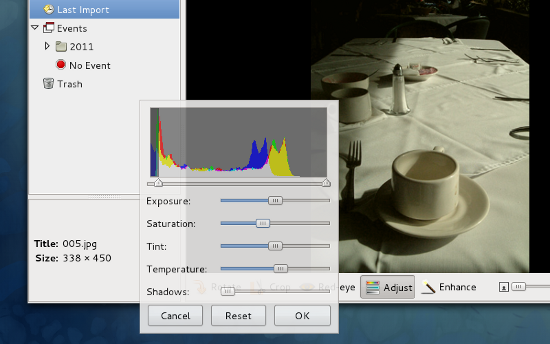It seems we all have digital cameras these days, even if only in a cell phone or a computer. With so many pictures being taken, it's awfully helpful to have an application dedicated to viewing them, browsing through them all, making minor adjustments to make them better reflect the fond memories they inspire. Linux ships with Shotwell, a photo manager and digital darkroom that should suit most people's needs for a fast, easy-to-use photo organizer.
Shotwell can be launched from the Activities Overview and in fact is probably already in your Favourites bar on the left in Activities Overview.
The first thing you'll do is import photographs into the application. This can be done in many different ways, given the many different possible sources of photographs. If your photographs exist on a CD or an SD card or on a hard drive (perhaps from another computer), then all you need to do is insert that disk, card, or drive, and choose to Import the pictures from the left column of Shotwell, or select the Import From Folder option in the File menu of Shotwell.
Of course, a great number of photographs these days come from phones. Getting photos from your phone or similar mobile device can be transferred to your computer over Bluetooth if your computer is has that feature. Finding out is easy; open the Activities Overview and type in Bluetooth into the search field. Open the Bluetooth Preferences. If your computer has Bluetooth then it will show up here, and you can pair your computer to your phone and then transfer files. Otherwise, you can plug your phone into your computer and treat it as a USB drive, or simply email yourself photos from the device.
Once your photographs have been imported, you can browse through them as thumbnails, and organize them into "Events" by selecting a number of photographs that should be grouped together and then selecting the Events menu to create a New Event (or hit control-N with the photos selected).

Modifying the photographs with simple, traditional darkroom techniques can be done automatically by clicking the Enhance button at the bottom of the screen. This lets the computer analyze and make basic improvements to the photo. For more control, double click on the photograph and all of the finer controls appear at the bottom of Shotwell's screen. You can crop your photo, correct for red-eye, rotate, or adjust color saturation, contrast, exposure, and more.

The typical workflow is to ingest the photos, correct and adjust them, and then post them to some photo sharing site online. Shotwell makes this easy from the main screen: select the photos you want to post online and click the Publish button at the bottom of the Shotwell window. You can post automatically from Shotwell to Flickr, Picasa, Facebook, and Piwigo.
If you want to send the photos to some other online service or email them individually to friends, you can export your adjusted photograph out of Shotwell. To do this, select the photograph or photographs you want to export, click on the File menu, and select Export. You can export the photo in a number of formats; the best for email or integrating into a website is png or jpg. You may define a new size for the photograph, and then click OK.
If you feel that Shotwell is too pedestrian for you and require something more professional-grade, you will want to look at Digikam and GIMP. The former is a full-featured digital darkroom application and the latter is a Photoshop-like re-touching and graphic design tool. Both of these can be found in the Add/Remove Software application from Activities Overview.

